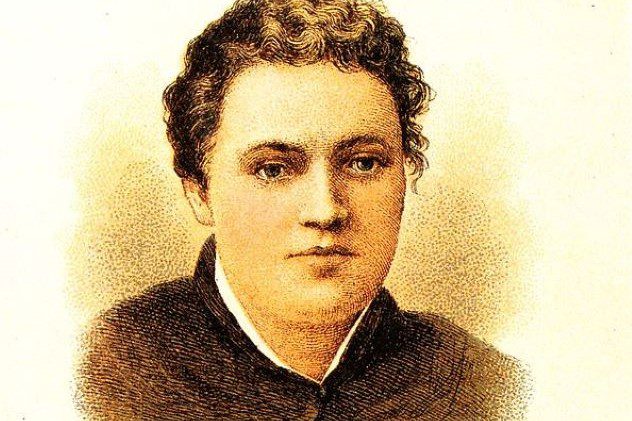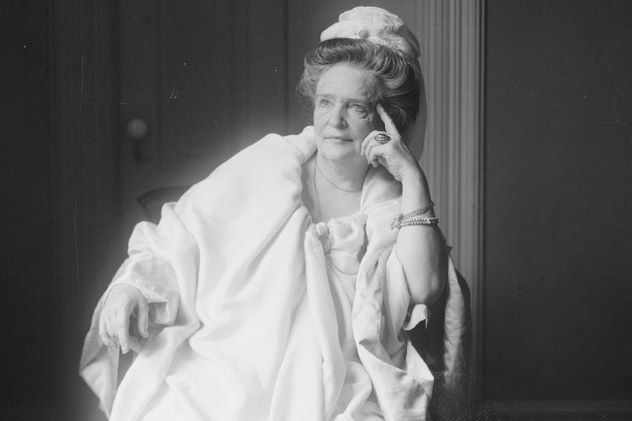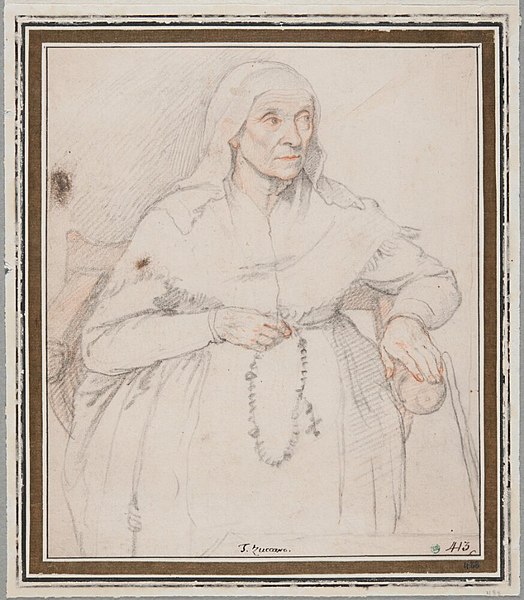 Music
Music  Music
Music  History
History 10 Less Than Jolly Events That Occurred on December 25
 Weird Stuff
Weird Stuff 10 Funny Ways That Researchers Overthink Christmas
 Politics
Politics 10 Political Scandals That Sent Crowds Into the Streets
 Weird Stuff
Weird Stuff Ten Bizarre Facts About The Doge Meme
 Our World
Our World 10 Ways Your Christmas Tree Is More Lit Than You Think
 Movies and TV
Movies and TV The 10 Coolest Stars to Set Sail on The Love Boat
 History
History 10 Things You Didn’t Know About the American National Anthem
 Technology
Technology Top 10 Everyday Tech Buzzwords That Hide a Darker Past
 Humans
Humans 10 Everyday Human Behaviors That Are Actually Survival Instincts
 Music
Music 10 Surprising Origin Stories of Your Favorite Holiday Songs
 History
History 10 Less Than Jolly Events That Occurred on December 25
 Weird Stuff
Weird Stuff 10 Funny Ways That Researchers Overthink Christmas
Who's Behind Listverse?

Jamie Frater
Head Editor
Jamie founded Listverse due to an insatiable desire to share fascinating, obscure, and bizarre facts. He has been a guest speaker on numerous national radio and television stations and is a five time published author.
More About Us Politics
Politics 10 Political Scandals That Sent Crowds Into the Streets
 Weird Stuff
Weird Stuff Ten Bizarre Facts About The Doge Meme
 Our World
Our World 10 Ways Your Christmas Tree Is More Lit Than You Think
 Movies and TV
Movies and TV The 10 Coolest Stars to Set Sail on The Love Boat
 History
History 10 Things You Didn’t Know About the American National Anthem
 Technology
Technology Top 10 Everyday Tech Buzzwords That Hide a Darker Past
 Humans
Humans 10 Everyday Human Behaviors That Are Actually Survival Instincts
Ten Female Swindlers from the Gilded Age
If you studied the Gilded Age in history class, the women you learned about were probably reformers like Carrie Nation, Ida B. Wells, and Jane Addams—advocates for change with hearts of gold and nerves of steel. But they weren’t the only ambitious women shattering stereotypes in the late nineteenth century. A rash of female con artists turned to less savory, more lucrative pursuits. Here are ten women who swindled their way through the Gilded Age.
Related: Top 10 Little-Known Facts About Victorian Era Scotland Yard
10 Ellen Peck

Photo credit: Wikimedia Commons
If you were a New Yorker in the nineteenth century, chances were good that you were swindled by Ellen Peck. Her career spanned five decades and countless victims. In 1892, assuming she had retired, police put her lifetime take at $1,000,000 (around $30,000,000 today). But they were wrong; Ellen kept right on scamming.
Her first big score came in 1878. That year, she conned soapmaking millionaire Benjamin Babbitt by pretending to be a detective who could track down bonds that had been stolen from him. Around the same time, she swindled notorious jewel fence, John Grady. Posing as a woman of wealth, Ellen offered to sell his wares to her wealthy friends. Grady eagerly gave her his stolen jewels.
Decades passed. Ellen piled up frauds. In 1909, at age 68, she was once more convicted of swindling. Her gray hair tucked into a bonnet, she received ten years behind bars. Newspapers considered it a death sentence. But two years later, the governor pardoned her. At seventy-one, she was too old to menace the city any longer.
Ellen took the pardon as a challenge. In 1914, she conned a man by offering him a share of her (imaginary) mining interests. She was 82 years old.[1]
9 Mabel Parker

Photo credit: Wikimedia Commons
In June of 1899, seventeen-year-old Mabel Preece married James Parker. Within a few years, the Parkers had picked up a side hustle to make ends meet—defrauding banks.
First, an unnamed accomplice snuck letters out of strangers’ mailboxes. Mabel picked out the checks, then forged the signatures on them onto blank ones. James passed her forgeries at stores. For a time, the scheme raked in over a hundred dollars a day. However, in the summer of 1903, James was arrested. Mabel followed not long after.
Stuck behind bars and thrust into the spotlight, Mabel made herself an agent of chaos. In jail, she played pranks and flouted rules. At trial, she spoke freely with reporters and sketched mocking caricatures. During closing arguments, she audibly hummed, “sticks and stones can hurt my bones, but words can never harm me.”
She even penned her own narrative of the trial. In Mabel’s version, she was a brave, long-suffering heroine. Those aligned against her were villains. The deputy sheriff was “greasy.” A victim was “heavy.” The prosecutor was “puffy with importance.” On December 11, 1903, her article made the front page of Joseph Pulitzer’s Evening World. Mabel’s antics earned her a hung jury. She was later re-tried and convicted. [2]
8 Bertha Heyman

Photo credit: Wikimedia Commons
If you encountered Bertha Heyman in the 1880s, you were probably left both star-struck and cash poor. Bertha always presented herself as rich but temporarily in need of money. She could often be found in a fancy hotel suite, draped in fine silk, surrounded by servants. The problem was… she wasn’t rich.
Yet time after time, Bertha’s confidence scheme worked. Men routinely handed her their money. Liquor dealer Charles Brandt fell for it twice, in 1879 and again in 1881. In 1880, train conductor Edward Perrin quit his job to take an imaginary position managing her imaginary estate. He then gave her his life savings. The con even worked while she was in prison in the early 1880s.
Bertha conned purely for the love of the game. “I take no pride in overvailing a fool,” she told a policeman in 1883. “The moment I discover a man’s a fool, I let him drop, but I delight in getting into the confidence and pockets of men who think they can’t be ‘skinned.’ It ministers to my intellectual pride.”
In the 1890s, Bertha moved out west and started a stage career. Audiences could see her wrestle in exhibition matches.[3]
7 Sarah Casselman

Photo credit: Wikimedia Commons
Sarah Casselman, the “Boarding-House Ravager,” specialized in domiciling and dashing. She targeted New York City’s most fashionable boarding houses in the 1870s, racking up aliases and unpaid bills.
She often posed as the relative of a judge, casually dropping intimate details about social elites. Other boarders weren’t safe once Sarah walked through the door—more than once, she tried to have guests kicked so she could co-opt their space. And despite not having a cent to her name, Sarah rarely found even the finest accommodations suitable, adding a piano here, renovating stables there.
Sarah was caught in 1876. Upon her arrest, she insisted that her claims to illustrious relatives and vast estates were true. A court-appointed physician diagnosed her with “monomania” and declared her not guilty by reason of insanity.[4]
6 Sarah Howe
If Sarah Howe had had a slogan, it might have been “women helping women swindle other women.” In 1877, Sarah organized the Ladies’ Deposit Company in Boston. The bank, run mostly by women, guaranteed an 8% monthly return. There was a catch, however—only unmarried women could join. According to Sarah, rich Quakers funded the bank, and they insisted it be used to help poor, single women.
For a few years, the Ladies’ Deposit did good business. Glowing word of mouth spread, snagging patrons across New England. The crash came in 1880 after skeptical newspaper articles led to a run on the bank. As it turned out, there was no Quaker fund. In 1881, a jury found Sarah guilty of obtaining money under false pretenses. She was sentenced to three years in jail.
Not long after her release, her bank was back in business. But in 1887, a depositor knocked at her door to be greeted with troubling news: Sarah—and $50,000—had vanished. She died penniless in 1892.[5]
5 Cassie Chadwick
By far, the most ambitious swindler of Gilded Age America was Cassie Chadwick. Only, if you lived in Cleveland at the turn of the century, you might have thought of her as Cassie Carnegie, Andrew Carnegie’s secret, illegitimate daughter.
In 1897, Cassie appeared from nowhere to marry Dr. Leroy Chadwick and moved into his mansion on Millionaire’s Row. Behind closed doors, she spread the word that her biological father was none other than the richest man in America, Andrew Carnegie. She even used his forged signature on legal documents.
Over the next seven years, Cassie borrowed fantastic amounts of money. She filled the Chadwick mansion with fine artwork and novelties and bought diamonds by the peck.
The scheme worked until 1904 when her web of creditors stretched too thin. Carnegie himself was forced to issue a statement denying the rumors. In the resulting chaos, banks crashed, and businessmen lost both face and fortune.
Cassie’s final haul was at least $2,000,000 ($56,000,000 today) and likely much higher. Many of her victims quietly took their losses to avoid scandal. She died in prison in 1907.[6]
4 Ann O’Delia Diss Debar

Photo credit: Wikimedia Commons
Among the era’s many clairvoyant swindlers, Ann O’Delia Diss Debar stood out from the crowd. Harry Houdini, an ardent debunker of mediums, considered her “one of the most extraordinary fake mediums and mystery swindlers the world has ever known.”
O’Delia’s most notable con came in New York, where she produced spirit paintings—i.e., paintings supposedly created from beyond the grave. O’Delia would cover a painting with chalk, then, during a séance, wave her hand over it. A concealed sponge wiped the chalk away. She then pronounced the unveiled masterpiece the work of Raphael or Rembrandt.
Distinguished attorney Luther Marsh was particularly impressed by her talents. He consulted her often and, at the spirits’ urging, paid her handsomely. But he proved too perfect a dupe. In the spring, he proudly hosted an exhibition of spirit paintings. Instead of awe, the exhibition produced skepticism. On April 11, Ann O’Delia was arrested on fraud charges. The trial that resulted in her conviction proved embarrassing, as her methods were demonstrated in open court.
Prison did little to reform O’Delia. For years after her release, she traveled from city to city, masquerading as a mystic or a foreign princess. Eventually, she vanished completely from public record.[7]
3 Mary Hansen

Photo credit: Wikimedia Commons
In the summer of 1897, Brooklyn police were on the lookout for a ruthless female swindler. Over the past few years, she had conned the late Dr. Christopher Lott out of his life savings. She was described as elderly, with gray hair and eyes. Police immediately suspected that Ellen Peck had struck again.
A few days of investigation proved them wrong. Another grandmotherly grifter was responsible. By 1897, Mary Hansen, AKA “Dutch Mary,” had a long career as a con artist. She’d first become notorious in 1876 after swindling Jersey City residents out of thousands of dollars. At trial, her attorney successfully argued that a woman was simply incapable of cheating the high caliber of men that Mary was accused of defrauding.
Mary started conning Dr. Lott after they met in 1894. She confided to him that she was a Danish admiral’s wife. Her husband had millions to his name, but unfortunately, the federal government had possession of it. She needed cash to pay the legal fees to access it.
Dr. Lott began loaning her money. This continued until 1897 when the ailing doctor learned the truth. He passed away not long after. Mary was convicted of fraud and sent to prison.[8]
2 Annie Murphy

Photo credit: Wikimedia Commons
Unlike Sarah Casselman, Annie Murphy actually had relations in high places—her stepfather had served as a senator in Minnesota. However, at age twenty-five, she embarked on a whirlwind road trip, passing forged checks across the country.
She started in St. Louis in the fall of 1892, passing two bad checks. Surfacing in her hometown of St. Cloud, she used old friends and her stepfather’s reputation to collect $1,500 on more forged checks. From there, she hit Colorado, disguising herself as a man. Then came Maine, where she pretended to be searching for her birth father. As she zigzagged across the country changing backstories, a flurry of telegrams followed her, warning banks not to take her checks and offering rewards for her capture.
The telegrams finally caught up with her in Alabama. Her trial in St. Cloud attracted more onlookers than seats; some Minnesotans stood for hours to watch the proceedings. Annie was convicted of forgery and sentenced to four years in prison.[9]
1 Marion La Touche

Photo credit: Wikimedia Commons
Marion La Touche started posing as a stockbroker in Boston in 1876, renting out office space and running advertisements in local newspapers, promising extravagant monthly interest rates. Over the years, she flitted between Boston, Philadelphia, and New York, running her scam for as long as she could before disappearing.
Many of her victims were society women looking to turn a quick dollar. This worked to her advantage—police struggled to find anyone who would risk public embarrassment to testify against her. The nature of stock speculation also helped. When she did face prosecution, Marion insisted that she’d invested her clients’ money as she’d promised. Wall Street was a fickle beast. It wasn’t a crime to play the stock markets and lose.
Four prison terms later, at age 66, a prosecutor guessed her lifetime take was $100,000 (upward of $2,000,000 today).[10]








